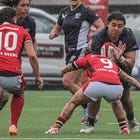Defining experiences
Two experiences during my time as a player and how they influence my coaching
Our experiences define us. Before I coached, and for a while at the start of my coaching journey, I played rugby. I loved every single second of playing, for lots of different reasons.
Whether it was the team I was playing in at the time, the individual goals I had for myself or playing knowing I had family member’s supporting on the sidelines.
I had lots of brilliant coaches who made training engaging and enjoyable for me.
There are less positive moments that I reflect on and that have informed my own approach to coaching.
Experience 1: Tackling
I first started playing at university. I had been a lifelong fan of rugby prior to this and couldn’t wait to play the sport.
Due to the landscape of female rugby at the time, university was the first chance I got to play. Prior to this, I had a complex relationship with taking part in sport. I was a sporty child, loved football camps, learnt karate, adored swimming and took part in open water swimming events, but felt disengaged by school PE.
Our university rugby team was filled with players who had never seen or played rugby before. Before my first ever match, I think I had one training session with the team (prior to joining the team I’d had on training session elsewhere which was worked on handling). During the session I remember we worked on passing, but very little contact.
When we were warming up for the match, the captain asked if I knew how to tackle. I said no. We did then 1-2 tackles as practice.
I think because I was comfortable on a rugby pitch, I was assumed to be an already competent player. I’d spent my life surrounded by rugby, whether watching it in stadiums or joining in junior rugby warm ups as a 5 year old. That, however, didn’t mean I knew how to tackle safely and effectively.
Unfortunately, I’m not alone in this experience. Researcher and friend Kathryn Dane found that female players often felt unprepared for contact games:
Participants reported “playing catch-up” and relied on resources such as “YouTube videos” and “teammates” for knowledge on how to tackle. Participants recalled matches in which they felt ill-prepared, akin to being “thrown in at the deep end” - Kathryn Dane, It’s always the bare minimum.
That first experience of contact informes my coaching practice. I try to weave in contact skills and develop confidence across a range of activities. Developing contact means a practice that is beyond hitting a few tackle pads every week or practicing on a player before kick off.
Grabbing, wrestling, practicing on a moving player and tracking a player down (i.e in touch rugby) are all ways to build up contact proficiency. Beyond that, developing players core movements is also important, ask any player I’ve coached and they’ll tell you I love a bearcrawl.
In previous teams I’ve coached, I’ve mentioned that there’s a sign off process. Players won’t be put into a contact match until both I and the player feel they’re ready.
Having that layer of security reassures players and has meant players have approached me after being absent at training to get re-signed off. It’s also meant players have understood I’ll be firm around whether they’re ready for contact, including as part of a return to play process.
This sometimes involves some very tough conversations, but always with the welfare of the player put first.
Read more:
Experience 2: Kit that fits
When I first started playing, the university I played for wasn’t known for sports. This meant that people organising the kit weren’t aware of the range of sizes needed for shirts.
For context, I’ve always had a broad frame. I love my frame and the abilities it gave me on a pitch.
However, I didn’t fit into any of the shirts we had for my first year of playing for my university (this did change the season after). The captain tried to obtain a larger size, but couldn’t get another team shirt.
Instead, I got an older fashioned jersey in the university colours (purple with a large yellow band across the middle) sourced from elsewhere. It looked completely different to the modern shirts with university logos my teammates were playing in.
I completely understood the situation. The captain was really apologetic and it wasn’t her fault. She went out of her way to try and rectify the situation.
It wasn’t really the fault of the student union either. They were learning what it meant to have a rugby union team. Next season, I got a team shirt that I could move in and that was the same as my teammates.
After that I started to show some flexibility and honesty across teams that I played for. If the team didn’t have shorts that fit me, I played in shorts that I chose for myself. It started to not bother me as much and became something I embraced.
Often, I wasn’t the only player who struggled with sizings and then individually measured shorts were purchased.
When my coaching brought me to leading grassroots women’s teams, I took my own experiences with kit with me. This has meant prioritising choice and comfort. Giving players the opportunity to try kit options on and give me feedback before a decision has been made.
I’ve also tried to order a range of sizes. Rugby is a game for all and the shirt sizes we organise should reflect this, from an extra small to a 6XL. Providing a range of choices meant people could pick a shirt they were most comfortable in.
If you’re unable to sign up for regular paid subscription, you can still buy me a coffee.





